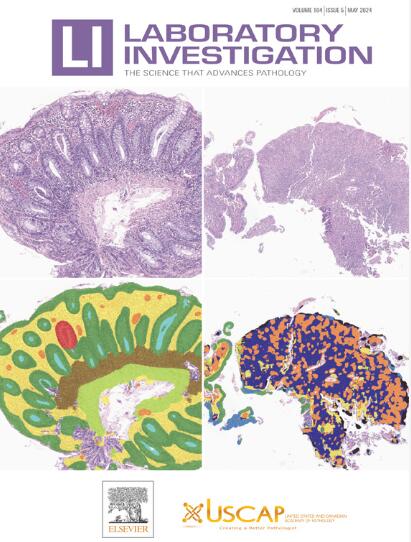Potential Role of PARVB in Macrophage-Mediated Immunosuppression and Cervical Cancer Progression
IF 4.2
2区 医学
Q1 MEDICINE, RESEARCH & EXPERIMENTAL
引用次数: 0
Abstract
This study aimed to identify and characterize novel macrophage–related molecular mechanisms underlying immunosuppression and tumor progression in cervical cancer. Through a systematic integrative analysis guided by immune-related gene signatures and robust regression modeling, we identified PARVB as a novel macrophage–associated prognostic gene with strong predictive value across multiple data sets. Further validation using large-scale transcriptomic data and single-cell RNA-sequencing profiles revealed that PARVB likely activates the SMAD signaling axis, leading to the upregulation of TNFSF13, a key driver of M2 macrophage polarization. This PARVB-SMAD3-TNFSF13 axis enhances interactions between M2 macrophages and TNFSF13+ subsets, promoting regulatory T-cell induction and fostering an immunosuppressive tumor microenvironment. Functional assays and multiplex immunohistochemistry further confirmed that this axis drives tumor proliferation and immune evasion. Collectively, our findings uncover a critical PARVB-driven signaling cascade that reprograms macrophages into an immunosuppressive M2 phenotype, facilitating immune escape and cervical cancer progression. Targeting this axis presents a promising therapeutic strategy to reshape the tumor microenvironment and improve immunotherapeutic outcomes.
PARVB在巨噬细胞介导的免疫抑制和宫颈癌进展中的潜在作用。
本研究旨在确定和描述宫颈癌免疫抑制和肿瘤进展的巨噬细胞相关的新分子机制。通过免疫相关基因特征和稳健回归模型指导的系统综合分析,我们确定PARVB是一种新的巨噬细胞相关预后基因,在多个数据集中具有很强的预测价值。利用大规模转录组学数据和单细胞rna测序(scRNA-seq)谱进一步验证表明,PARVB可能激活SMAD信号轴,导致TNFSF13上调,TNFSF13是M2巨噬细胞极化的关键驱动因素。PARVB-SMAD3-TNFSF13轴增强M2巨噬细胞与TNFSF13+亚群之间的相互作用,促进调节性T细胞(Treg)诱导并培养免疫抑制的肿瘤微环境。功能分析和多重免疫组化进一步证实了该轴驱动肿瘤增殖和免疫逃避。总的来说,我们的发现揭示了一个关键的parvb驱动的信号级联,将巨噬细胞重编程为免疫抑制的M2表型,促进免疫逃逸和宫颈癌的进展。靶向这一轴是重塑肿瘤微环境和改善免疫治疗结果的一种有希望的治疗策略。
本文章由计算机程序翻译,如有差异,请以英文原文为准。
求助全文
约1分钟内获得全文
求助全文
来源期刊

Laboratory Investigation
医学-病理学
CiteScore
8.30
自引率
0.00%
发文量
125
审稿时长
2 months
期刊介绍:
Laboratory Investigation is an international journal owned by the United States and Canadian Academy of Pathology. Laboratory Investigation offers prompt publication of high-quality original research in all biomedical disciplines relating to the understanding of human disease and the application of new methods to the diagnosis of disease. Both human and experimental studies are welcome.
 求助内容:
求助内容: 应助结果提醒方式:
应助结果提醒方式:


